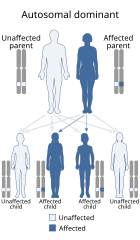Epiblepharon
| Epiblepharon | |
|---|---|
 | |
| This condition is inherited in an autosomal dominant manner. | |
| Specialty | Medical genetics |
Epiblepharon is a condition characterised by a congenital horizontal fold of skin near the margin of the upper or lower eyelid caused by the abnormal insertion of muscle fibres. This extra fold of skin redirects the lashes into a vertical position, where they may contact the globe of the eye, affecting the cornea or the conjunctiva.[1] This is found most commonly in Asian individuals, especially children. One estimate puts the percentage of affected Asian children aged 7–14 years old at 12.6%.[2]
References
- ^ "Epiblepharon". Elements of Morphology. National Human Genome Research Institute. Retrieved 2022-10-30.
- ^ Katowitz, James A.; Katowitz, William R. (2017-11-30). Pediatric Oculoplastic Surgery. Springer. p. 336. ISBN 9783319608143.
Further reading
- Woo, Kyung In; Kim, Yoon-Duck (2016). "Management of epiblepharon". Current Opinion in Ophthalmology. 27 (5). Ovid Technologies (Wolters Kluwer Health): 433–438. doi:10.1097/icu.0000000000000285. ISSN 1040-8738.
- Johnson, C C (1968). "Epiblepharon". Transactions of the American Ophthalmological Society. 66. American Ophthalmological Society. PMC 1310293. PMID 4888957.
External links
- Epiblepharon - EyeWiki
- Congenital and Acquired Epiblepharon - EyeWiki
